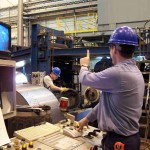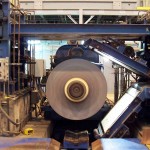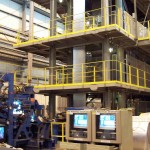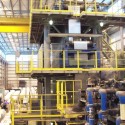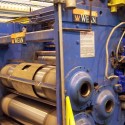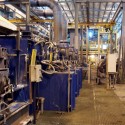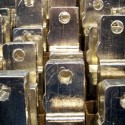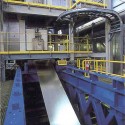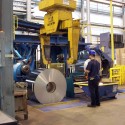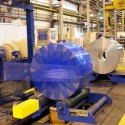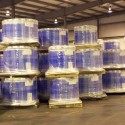Every step in production from coil receiving to final shipping is computer controlled. This sophisticated system monitors essential data continuously and provides each coil with a complete production history: gauges, coating weights, tension leveler specs, trimmed widths, pin hole count, lab tests, coating weight, and much more. Every bit of information that defines the quality of the product is recorded. When the coil is ready for shipment, the history becomes documented proof that the product meets every customer specification. Each section of the process line generates its own significant contribution to the quality of the finished coil. Premium black plate enters the line at one end and in a single, uninterrupted journey leaves the plant as on-spec, prime, palleted and wrapped tin plated coil.
Clicking individual images will float larger image over the content of this page. You can navigate through each gallery using the provided links or by clicking on the larger image. Click the “close” link or on this page to return.
Entry Section
- Has the capacity to store over 5,000 tons of high quality black plate
- Welding: Joins the coils with narrow lap seam welds that cause minimal gauge variation at the weld. This allows the line to run continuously and allows the customer maximum usable strip.
- Looper: Stores the strip in order to provide a continuous flow of product to the process section of the line.
Process Sections
- Cleaning: Removes dirt and oil from the strip. This is done in two steps: a pre-cleaning tank with a scrubber line tank removes most of the dirt and oil. Next, the cleaning tank removes any residual contaminants by applying an electrical current to the grids. A common alkaline cleaning is used.
- Tension Leveler: Reduces camber and crossbow. Provides the strip with the maximum uniformity of flatness.
- In-Line Side Trimmer: Controls the specified width of the product to better-than-industry standards. All scrap is bundled and recycled.
- Pickler: Removes any metal oxides and contaminants left on the strip and etches the surfaces of the strip for better adhesion of the tin coating.
- Plating: An environmentally friendly methane-sulphonic acid based process that deposits a uniform, specified amount of tin on either side of the strip, reduces dendritic growth, dust, and gray edges. Offers a brighter surface for litho applications.
- Evaporator: The plating rinse holding tank feeds into the evaporator which allows for the recovery of valuable plating chemicals.
- Flux: The flux process removes residual plating solution and leaves a thin acid salt film on the strip surface which inhibits the formation of tin oxides.
- Differential Marking: “Stamps” the strip with a code that differentiates which side of the strip has heavy or light coating.
- Reflow: A 100% solid state induction heated process. Provides an instantaneous change in surface of product, from matte to mirror. Woodgrain is eliminated at this stage of production.
- Quench: After the reflow, the strip is quickly cooled in a deionized water quench tank that keeps the bright appearance of the strip after being melted.
- Chemical Treatment: Offers a chrome passivation process that removes tin oxides from strip. Gives corrosion protection, reduces staining, and discoloration during storage. Enhances the adhesion of lacquers during can manufacturing.
- Electrostatic Oiler: Gives a light coating of ATBC (Acetyl-Tributly- Citrate) oil so that the strip feeds smoothly through customer’s machinery.
- Cleaning
- Cleaning
- Tension Leveler
- Tension Leveler
- In-Line Side Trimmer
- Pickler
- Plating
- Evaporator
- Flux
- Differential Marking
- Reflow
- Quench
- Electrostatic Oiler
Exit Section
This is the final inspection station. The strip is checked for imperfections, variances from specifications, pin hole detection, etc. before it can be wrapped and shipped to the customer.
- Exit Section
- Exit Section
- Exit Section
Wrapping / Storage
Each coil is palleted and automatically stretch wrapped then stored in a climate controlled warehouse until shipped by truck, train, or barge.
- Wrapping
- Wrapping
- Storage
A collection of Environmental Devices: The Ohio Coatings Company operation is the most environmentally responsible tin mill in the nation. The waste water generated during production is a fraction of that in older mills. Before the water is returned to the Ohio River, it goes through a series of five sophisticated cleaning processes: it is returned cleaner than the river itself. Air Quality gets similar serious treatment. Fumes created during manufacturing are scrubbed with a fan air cleaning system. Even the shipping materials make an environmental statement: the plastic stretch wrap and wooden shipping pallets are 100% recyclable.

